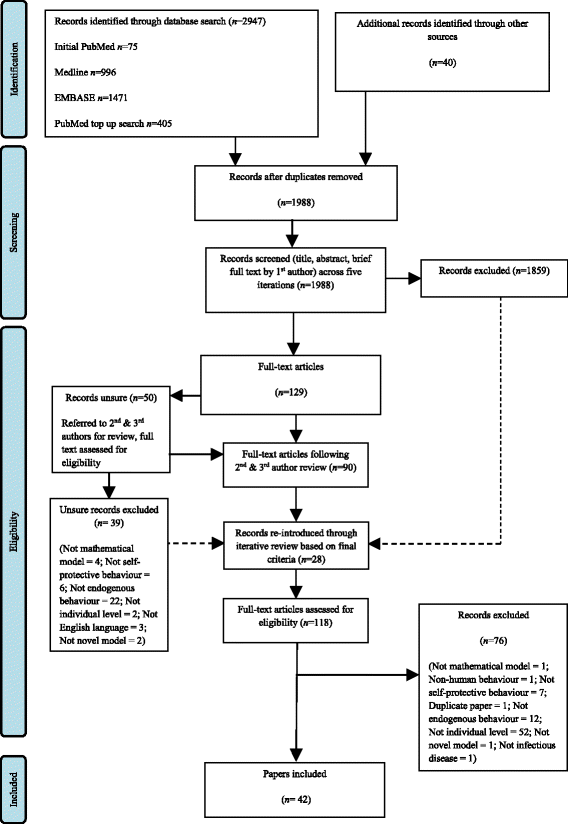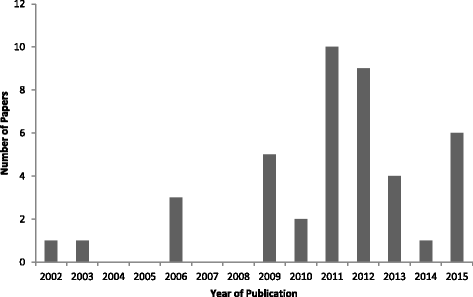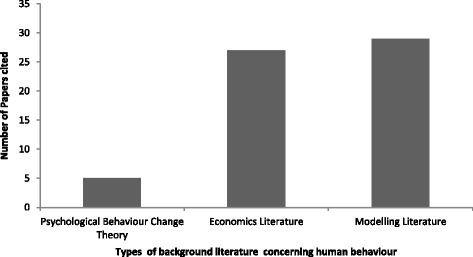Infection prevention behaviour and infectious disease modelling: a review of the literature and recommendations for the future
- PMID: 29523125
- PMCID: PMC5845221
- DOI: 10.1186/s12889-018-5223-1
Infection prevention behaviour and infectious disease modelling: a review of the literature and recommendations for the future
Abstract
Background: Given the importance of person to person transmission in the spread of infectious diseases, it is critically important to ensure that human behaviour with respect to infection prevention is appropriately represented within infectious disease models. This paper presents a large scale scoping review regarding the incorporation of infection prevention behaviour in infectious disease models. The outcomes of this review are contextualised within the psychological literature concerning health behaviour and behaviour change, resulting in a series of key recommendations for the incorporation of human behaviour in future infectious disease models.
Methods: The search strategy focused on terms relating to behaviour, infectious disease and mathematical modelling. The selection criteria were developed iteratively to focus on original research articles that present an infectious disease model with human-human spread, in which individuals' self-protective health behaviour varied endogenously within the model. Data extracted included: the behaviour that is modelled; how this behaviour is modelled; any theoretical background for the modelling of behaviour, and; any behavioural data used to parameterise the models.
Results: Forty-two papers from an initial total of 2987 were retained for inclusion in the final review. All of these papers were published between 2002 and 2015. Many of the included papers employed a multiple, linked models to incorporate infection prevention behaviour. Both cognitive constructs (e.g., perceived risk) and, to a lesser extent, social constructs (e.g., social norms) were identified in the included papers. However, only five papers made explicit reference to psychological health behaviour change theories. Finally, just under half of the included papers incorporated behavioural data in their modelling.
Conclusions: By contextualising the review outcomes within the psychological literature on health behaviour and behaviour change, three key recommendations for future behavioural modelling are made. First, modellers should consult with the psychological literature on health behaviour/ behaviour change when developing new models. Second, modellers interested in exploring the relationship between behaviour and disease spread should draw on social psychological literature to increase the complexity of the social world represented within infectious disease models. Finally, greater use of context-specific behavioural data (e.g., survey data, observational data) is recommended to parameterise models.
Keywords: Human behaviour; Infectious disease; Literature review; Mathematical modelling; Protective behaviour.
Conflict of interest statement
Ethics approval and consent to participate
Not applicable
Consent for publication
Not applicable
Competing interests
The authors declare that they have no competing interests.
Publisher’s Note
Springer Nature remains neutral with regard to jurisdictional claims in published maps and institutional affiliations.
Figures



Similar articles
-
Examining the application of behaviour change theories in the context of infectious disease outbreaks and emergency response: a review of reviews.BMC Public Health. 2020 Oct 1;20(1):1483. doi: 10.1186/s12889-020-09519-2. BMC Public Health. 2020. PMID: 33004011 Free PMC article. Review.
-
Avoiding and identifying errors in health technology assessment models: qualitative study and methodological review.Health Technol Assess. 2010 May;14(25):iii-iv, ix-xii, 1-107. doi: 10.3310/hta14250. Health Technol Assess. 2010. PMID: 20501062 Review.
-
Nine challenges in incorporating the dynamics of behaviour in infectious diseases models.Epidemics. 2015 Mar;10:21-5. doi: 10.1016/j.epidem.2014.09.005. Epub 2014 Sep 28. Epidemics. 2015. PMID: 25843377
-
Modelling the influence of human behaviour on the spread of infectious diseases: a review.J R Soc Interface. 2010 Sep 6;7(50):1247-56. doi: 10.1098/rsif.2010.0142. Epub 2010 May 26. J R Soc Interface. 2010. PMID: 20504800 Free PMC article. Review.
-
Incorporating social vulnerability in infectious disease mathematical modelling: a scoping review.BMC Med. 2024 Mar 18;22(1):125. doi: 10.1186/s12916-024-03333-y. BMC Med. 2024. PMID: 38500147 Free PMC article.
Cited by
-
Examining the application of behaviour change theories in the context of infectious disease outbreaks and emergency response: a review of reviews.BMC Public Health. 2020 Oct 1;20(1):1483. doi: 10.1186/s12889-020-09519-2. BMC Public Health. 2020. PMID: 33004011 Free PMC article. Review.
-
Triple contagion: a two-fears epidemic model.J R Soc Interface. 2021 Aug;18(181):20210186. doi: 10.1098/rsif.2021.0186. Epub 2021 Aug 4. J R Soc Interface. 2021. PMID: 34343457 Free PMC article.
-
A behaviour and disease transmission model: incorporating the Health Belief Model for human behaviour into a simple transmission model.J R Soc Interface. 2024 Jun;21(215):20240038. doi: 10.1098/rsif.2024.0038. Epub 2024 Jun 5. J R Soc Interface. 2024. PMID: 38835247 Free PMC article.
-
A multilevel social network approach to studying multiple disease-prevention behaviors.Sci Rep. 2025 Jan 11;15(1):1718. doi: 10.1038/s41598-025-85240-7. Sci Rep. 2025. PMID: 39799220 Free PMC article.
-
Incorporating Social Determinants of Health into Modelling of COVID-19 and other Infectious Diseases: A Baseline Socio-economic Compartmental Model.Soc Sci Med. 2021 Apr;274:113794. doi: 10.1016/j.socscimed.2021.113794. Epub 2021 Feb 23. Soc Sci Med. 2021. PMID: 33662772 Free PMC article.
References
-
- Anderson RM, May RM. Infectious disease of humans: dynamics and control. Oxford: Oxford University Press; 1992.
-
- Rvachev LA, Longini I. A mathematical model for the global spread of influenza. Math Biosci. 1985;75:3–22. doi: 10.1016/0025-5564(85)90064-1. - DOI
-
- Anderson RM. The role of mathematical models in the study of HIV transmission and the epidemiology of AIDS. J Acquir Immune Defic Syndr. 1988;1:241–256. - PubMed
-
- Ngwa GA, Shu WS. A mathematical model for endemic malaria with variable human and mosquito populations. Math Comput Model. 2000;32:747–763. doi: 10.1016/S0895-7177(00)00169-2. - DOI
Publication types
MeSH terms
Grants and funding
LinkOut - more resources
Full Text Sources
Other Literature Sources

